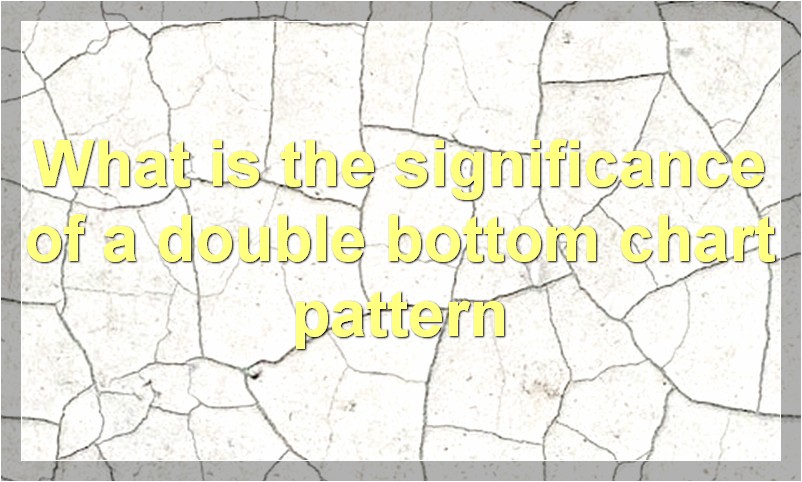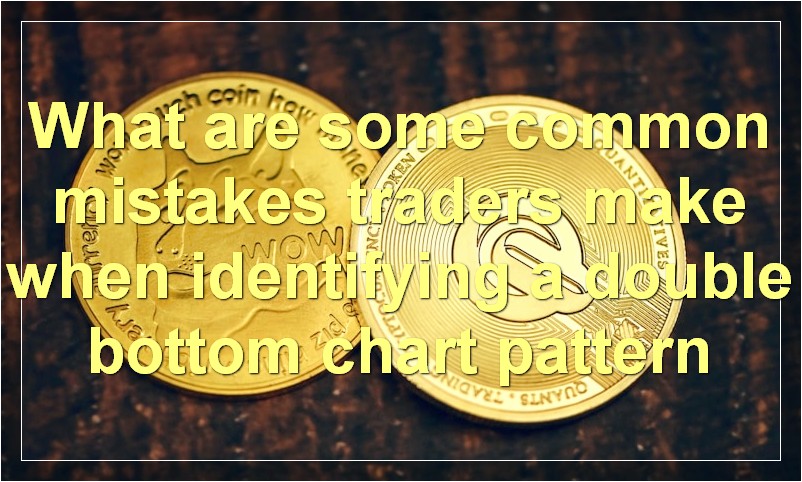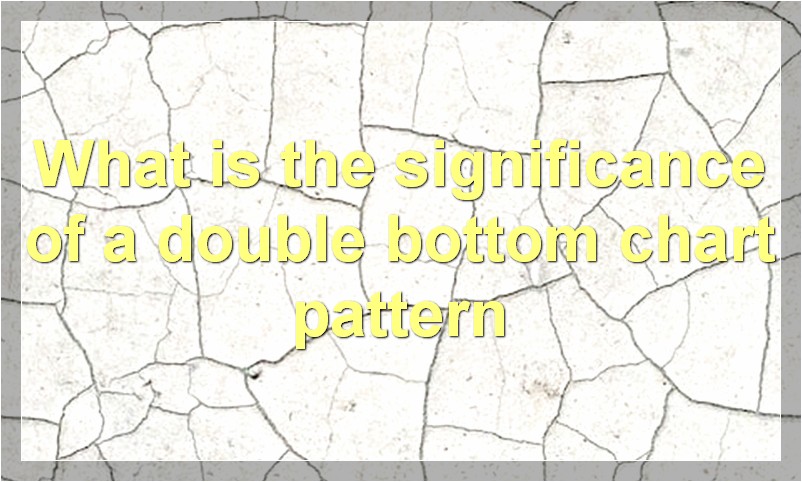The double bottom chart pattern is one of the most reliable patterns in technical analysis. This pattern occurs when a stock price hits a support level, bounces back up, and then retests the support level again before finally breaking out. The double bottom pattern signals that the stock is ready to move higher and that the previous downtrend has reversed.
What is a double bottom chart pattern
When it comes to technical analysis, there are a variety of chart patterns that can be used to help identify potential trading opportunities. One such pattern is known as a double bottom.
A double bottom is a bullish reversal pattern that forms after a prolonged downtrend. It is identified by two distinct lows that bottom out at roughly the same price level. The second low typically forms with increased buying volume, which is seen as a confirmation of the trend reversal.
Once the pattern is complete, traders will often look for a breakout above the resistance level formed by the highs between the two lows. If successful, this can lead to a sharp rally higher as buyers rush in to take advantage of the new uptrend.
While double bottoms can be potent reversal signals, it’s important to keep in mind that they don’t always lead to an immediate rally. In some cases, prices may consolidate for a period of time before eventually breaking out higher. As such, it’s important to wait for confirmation before taking any action.
What is the significance of a double bottom chart pattern

The double bottom chart pattern is a technical analysis tool that is used to predict future price movements in a security. The pattern is created when there are two consecutive lows followed by a higher low. The double bottom chart pattern is considered to be a bullish reversal pattern and can be used to signal that the security is about to see an increase in price.
How is a double bottom chart pattern created
The double bottom chart pattern is created when the price of an asset creates two lows at approximately the same level. The second low is typically lower than the first, but not by much. These lows are followed by a period of consolidation and then a breakout to the upside.
The double bottom chart pattern is considered a bullish reversal pattern, as it indicates that the price has found support at this level and is now ready to move higher. This pattern can be used to enter a long position, with the stop-loss placed just below the second low.
What are the characteristics of a double bottom chart pattern
A double bottom chart pattern is a technical analysis tool that helps traders identify potential reversals in stock prices. The pattern is created when the stock price creates two distinct lows, and is considered a bullish signal. Some of the key characteristics of a double bottom chart pattern include:
-The two lows are typically equal or very close in price
-There is a moderate to significant rebound after the first low is hit
-The second low is usually accompanied by increased volume
-The pattern is confirmed when the stock price breaks above the resistance level created by the highs between the two lows
How can a double bottom chart pattern be used to predict future price movements
The double bottom chart pattern is a technical analysis tool that is used to predict future price movements. The pattern is created when there are two consecutive lows in price, followed by a higher low. This higher low signals a potential reversal in the current trend. The double bottom pattern is confirmation that buyers are starting to enter the market and that prices may start to move higher.
The double bottom pattern can be used as a standalone tool to make trading decisions or it can be used in conjunction with other technical indicators. When using the pattern alone, traders will typically buy when the price breaks above the neckline (the line connecting the two lows). A stop loss can be placed below the second low to manage risk.
When using the double bottom pattern with other technical indicators, traders will often wait for confirmation before entering a trade. For example, they may wait for the price to break above the 200-day moving average or for momentum indicators to turn positive before buying.
The double bottom pattern is a reliable tool that can be used to profit from reversals in both uptrends and downtrends. However, like all technical indicators, it is not perfect and there will be false signals. Traders need to use caution when trading this pattern and should always employ risk management strategies to protect their capital.
What are some common mistakes traders make when identifying a double bottom chart pattern

When it comes to technical analysis, there are a lot of different chart patterns that traders can look for in order to identify potential trading opportunities. One of these chart patterns is known as a double bottom.
A double bottom is formed when the price of an asset declines to a certain level, bounces back up, and then declines again to that same level. This forms what looks like a “W” shape on the chart.
The key thing to look for when identifying a double bottom is that the second low is not as low as the first low. This indicates that there is some buying interest at that level and that the price could potentially rebound from there.
One mistake that traders sometimes make when trying to identify a double bottom is that they mistakenly think that the pattern has to be perfectly symmetrical. However, this is not the case. The pattern can be slightly asymmetrical and still be valid.
Another mistake that traders sometimes make is failing to identify the neckline. The neckline is the level at which the two lows are formed. This line represents a key level of support and resistance and should be used as such when making trading decisions.
Finally, another common mistake that traders make when trying to identify a double bottom is not giving the pattern enough time to play out. Double bottoms can take some time to form and if you try to enter too early, you could end up getting burned.
Overall, the double bottom is a valuable chart pattern to know how to identify. Just be sure to avoid these common mistakes and you’ll be well on your way to success.
How can a double bottom chart pattern be used in conjunction with other technical indicators
A double bottom chart pattern is a technical indicator that can be used in conjunction with other technical indicators to help identify potential reversals in a downtrend. The double bottom pattern is created when the price of an asset tests the same support level twice and fails to break below it. This pattern can be used to signal a possible reversal in the current downtrend and a potential buying opportunity.
When using the double bottom chart pattern in conjunction with other technical indicators, it is important to look for confirmation from the other indicators before making any trading decisions. For example, if the double bottom pattern is forming on a chart with a strong downtrend, it would be wise to wait for confirmation from other indicators before taking a long position. On the other hand, if the double bottom pattern is forming on a chart with a weak downtrend, it may be a good idea to take a long position sooner rather than later.
The double bottom chart pattern can be a valuable tool for traders when used in conjunction with other technical indicators. By itself, the pattern is not enough to make trading decisions, but it can be a helpful tool in identifying potential reversals in a downtrend.
What are some potential trade setups that can be generated from a double bottom chart pattern
A double bottom chart pattern can be a bullish reversal signal, indicating that the price is about to start moving higher. There are a few different ways to trade this pattern, and which one you use will depend on your own trading strategy and risk tolerance.
One way to trade a double bottom is to wait for the price to break above the resistance level (the second “bottom” in the pattern), and then enter a long position. A stop loss can be placed just below the second bottom, and the target can be set at a previous high.
Another way to trade a double bottom is to enter a long position when the price breaks above the resistance level, but place a stop loss just below the first bottom. This way, you will still capture any upside potential if the price starts to move higher, but you’ll limit your downside risk if the price reverses and starts to move lower again.
Which of these strategies you use is up to you, but both can be potential trade setups generated from a double bottom chart pattern.
What are some common pitfalls associated with trading a double bottom chart pattern
When it comes to trading a double bottom chart pattern, there are a few common pitfalls that you should be aware of. One of the most common mistakes is failing to identify the second bottom. This can lead to buying too early and missing out on potential profits. Another mistake is buying when the price is still falling towards the second bottom. This can result in getting caught in a losing trade. Finally, many traders fail to take into account the potential for a false breakout. If the price breaks above the neckline and then quickly falls back below it, this could trigger a wave of selling that takes prices lower than the original bottom.
Is there anything else that traders should know about the double bottom chart pattern
The double bottom chart pattern is a technical analysis tool that trader use to predict future price movements. This pattern is created when the price of an asset hits a low, bounces back up, and then hits the same low again. The second low is usually not as low as the first, and this creates the “double bottom.” The double bottom chart pattern is usually seen as a bullish signal, as it shows that the market has rejected the lower price twice.

